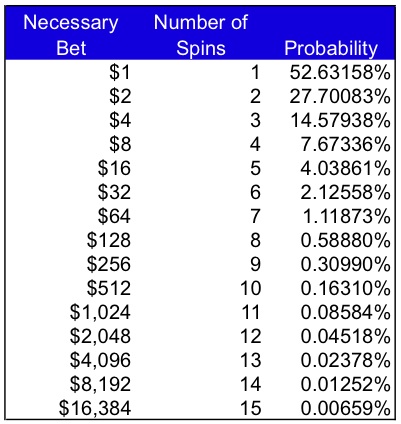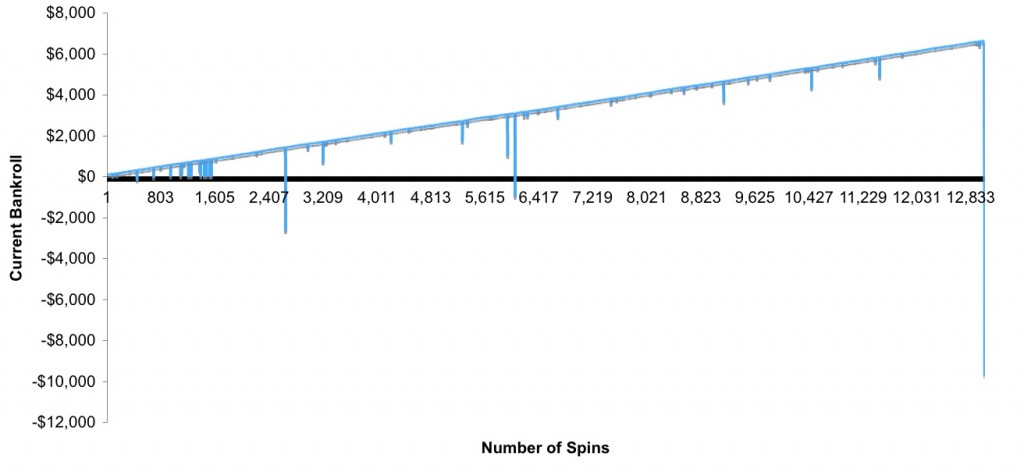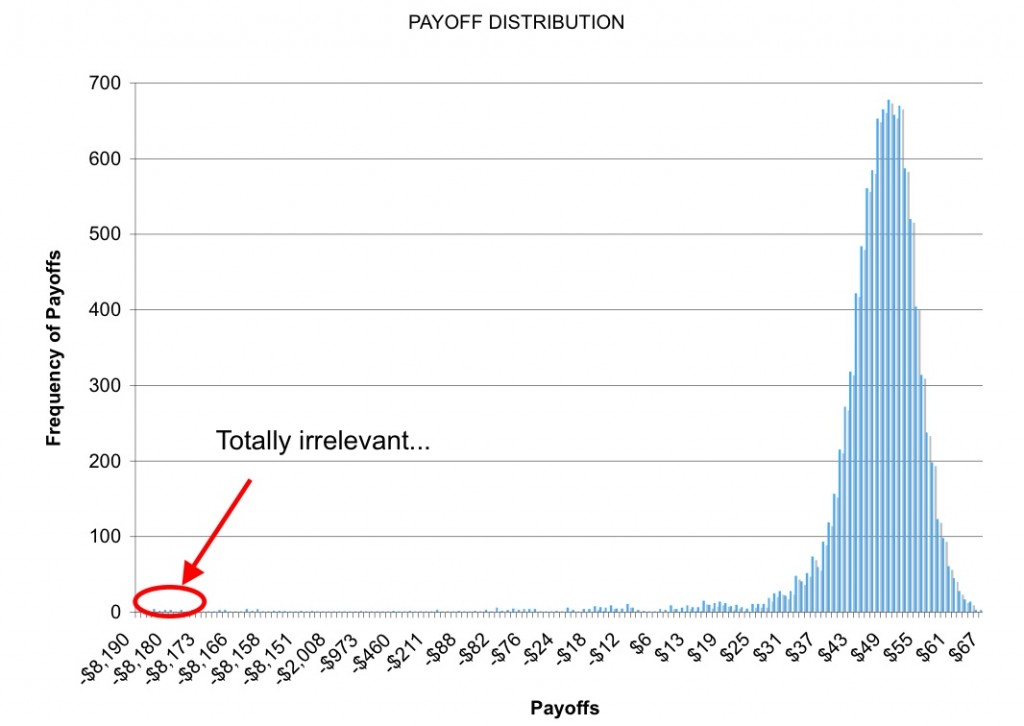A few years ago, friends and I took a pit stop in Macau during a trip through Asia after our graduation. While there, I came up with a fairly simple roulette strategy that I thought could work for someone with enough of a bankroll. Since then, my friend Steve and I have argued about 15x about the validity of this strategy. In fact, Steve even wrote a VBA program to prove that I was wrong. Well, Steve, I wrote my own program this past rainy Sunday (to highlight my gambling prowess, this Sunday I also doubled up in Texas Hold ‘EM poker after flopping a full house with 7, 2 off suite – but that’s a story for another day).
The strategy is as follows: put $1 on black. If you win, take your winnings off the table and put a new $1 bet down. If you lose, then put $2 down, if you lose again, double it to $4, if you lose again, double it to $8, and keep doubling down until you win, then take all of your money off the table (your winnings will offest your previous string of losses and leave you with a $1 profit), and start again with a $1 bet. Of course, the problem becomes, what happens when you lose 10 times in a row. Well, I’m glad you asked.
First off, let’s analyze the probability of you losing that many times in a row. There are 38 possibilities in a roulette wheel – numbers 1-36, 0, and 00. So, your chances of not hitting your color are ((38-18)/38, or about 53%. So, you don’t have a great chance of winning if you just play once. But, what are the chances of you losing several times in a row? The below table illustrates how low these odds become (‘Necessary Bet’ is the bet needed to recover losses and make $1. The ‘Probability’ is the cumulative probability of losing n many times in a row. See R1:T17 of the first tab of the excel I link to at the bottom of the post for the calculations):
Below is a graph of what your pay offs may look like. Note that you are winning only $1 at a time until you eventually get really unlucky, somewhere around your 13,000th spin in this case, and lose money beyond your bankroll which forces you to quit and walk out of Macau penniless (but hopefully not indebted to some Asian Gangsters). Notice how the blue bar suddenly drops to -$9,000…
This type of payoff structure is analogous to “picking up nickles in front of a steam roller.” If you haven’t already, you should read When Genius Failed, the story of the demise of Long Term Capital Management. LTCM was a hedge fund run by Nobel laureates who made thousands of tiny bets using computer programs in a strategy called statistical arbitrage, among others. The hedge fund blew up as they thought the scenarios that would cause their fund to collapse would only occur once every few centuries (it only took a few years for the fund to meet its very spectacular end in one of the first “too big to fail” situations. Fun fact: all Wall Street banks pitched in to help unwind the fund’s assets, and thus divert a systemic break in the economy, except for Bear Stearns who refused to help…).
Below is a zip file with three Python programs whose outputs are captured in the excel. The programs assume that you start with $100, and can borrow up to $5,000 from your friend (except for the last one that assumes you can borrow $15,000). So, just as LTCM relied on leverage to try to double down on their bets and save their fund, this strategy also relies on loans to stay afloat in bad times when the odds go against you.
The first program is what would happen if you sat down and played until you went bust. I ran this program once, and you make about $6,000 before hitting some bad luck and going bust (this is shown in the line graph above). The second program basically runs the first program 10,000 times in order to get an average payout. However, this one assumes you are only willing to play 100 games in a row as even 100 games would probably take a very long time in reality. The last program is the same as the second, except that the player can lose up to $15,000 before quitting, and, if they have played 100 games and are at a negative value at the 100th game, they will play until they either recoup their losses, or go bust and lose $15,000. This last scenario actually yields a positive expected value of about $4 (see the third table of the excel file I link to at the end of the post. Expected value is what you would expect to win, on average, if you played this strategy many times). Here is the distribution of returns from spending 10,000 nights in the casino with your friend that has $15,000 he can loan you if need be. Pay no attention to the long tails where you lose $8,000 – that’s like a 10 sigma event and would NEVER happen 🙂
Conclusion: is this an effective strategy? Not really. Even if you found a table that let you start with $1 bets, and you had the patience to sit down and do this, and you had the bankroll, it’s just not going to yield all that much cash over time.
Please feel free to look over my code and let me know if you come up with any other conclusions by modifying it! Also – I’m not a programmer – these scripts were very easy to do and took me only a few hours to write all three and conduct all analysis because Python is super easy! If you want to learn more, MIT has FREE courses on Python that you should check out. Enjoy!
To quote a really great “anti-recruiter” LinkedIn profile describing time spent at a large quant hedge fund: “I earn above-market returns 95% of years by collecting theta, selling volatility in the form of financial derivatives, naked short put options, and in summary, collect nickels and dimes in front of steam rollers, hoping the black swans never appear during my lifetime.”
Attachments:
Python programs: Roulette Programs




This will occur for a number of good reasons: Maybe It is geo-blocked
Apk Download – Free Download Mobile And PC Apk File
apk download
e-mail to. And maybe you don’t want to give
up your
Apk Download – Free Download Mobile And PC Apk File
apk download
In case you have rooted your gadget, Yalp Retail outlet can even update applications in the qualifications with none
input from
Apk Download – Free Download Mobile And PC Apk File
apk download
Yalp Shop is contrary to the other applications on this site—there is not
any World wide web Edition. Rather, you need to set
Apk Download – Free Download Mobile And PC Apk File
apk download
In addition, you’ll be able to scan the downloaded APK information applying
any of one’s most popular virus scanner apps
Apk Download – Free Download Mobile And PC Apk File
apk download
Cami Halısı Cami Halıları Cami Halı Fiyatları Akrilik Cami Halısı Seccadeli Cami Halısı Yün cami halısı Göbekli Cami Halısı Saflı Cami Halısı. Websitemize Göz Atabilirsiniz.. cami halısı
In case you are at an Workplace or shared community, you can request the community
Apk Download – Free Download Mobile And PC Apk File
apk download
Cami Halısı Cami Halıları Cami Halı Fiyatları Akrilik Cami Halısı Seccadeli Cami Halısı Yün cami halısı Göbekli Cami Halısı Saflı Cami Halısı. Websitemize Göz Atabilirsiniz.. cami halısı
Cami Halısı Cami Halıları Cami Halı Fiyatları Akrilik Cami Halısı Seccadeli Cami Halısı Yün cami halısı Göbekli Cami Halısı Saflı Cami Halısı. Websitemize Göz Atabilirsiniz.. cami halısı
apk file with the Google Perform on to your desktop plus your unit.
Apk Download – Free Download Mobile And PC Apk File
apk download
Cami Halısı Cami Halıları Cami Halı Fiyatları Akrilik Cami Halısı Seccadeli Cami Halısı Yün cami halısı Göbekli Cami Halısı Saflı Cami Halısı. Websitemize Göz Atabilirsiniz.. https://www.saricahali.com.tr
Observe Online Flicks APK: Ever inside of a condition when you’re
within the airport, your flight is delayed for hrs and there’s very little to complete but sit all over?
Apk Download – Free Download Mobile And PC Apk File
apk download
Right until now you’ve been caught, but a new on the net support identified as APK
Apk Download – Free Download Mobile And PC Apk File
apk download
Currently we can generate around a thousand+- apk data files on a daily basis.
Apk Download – Free Download Mobile And PC Apk File
apk download
Once again, if APKPure has doubts about the security or origins of the
application
Apk Download – Free Download Mobile And PC Apk File
apk download
Apk Downloader is a lightweight download manager that may be focused on supporting
Apk Download – Free Download Mobile And PC Apk File
apk download
As the APK documents set up apps on the procedure, they will pose
Apk Download – Free Download Mobile And PC Apk File
apk download
Cami Halısı Cami Halıları Cami Halı Fiyatları Akrilik Cami Halısı Seccadeli Cami Halısı Yün cami halısı Göbekli Cami Halısı Saflı Cami Halısı. Websitemize Göz Atabilirsiniz.. cami halısı
period of time (ordinarily fifteen to ninety times) the user
can determine no matter whether to purchase
Apk Download – Free Download Mobile And PC Apk File
apk download
Cami Halısı Cami Halıları Cami Halı Fiyatları Akrilik Cami Halısı Seccadeli Cami Halısı Yün cami halısı Göbekli Cami Halısı Saflı Cami Halısı. Websitemize Göz Atabilirsiniz.. cami halısı
Cami Halısı Cami Halıları Cami Halı Fiyatları Akrilik Cami Halısı Seccadeli Cami Halısı Yün cami halısı Göbekli Cami Halısı Saflı Cami Halısı. Websitemize Göz Atabilirsiniz.. cami halısı
Android Oreo is definitely the 8th main launch of the
Android running procedure. It had been initial released for a developer preview
on March
Apk Download – Free Download Mobile And PC Apk File
apk download
In some cases, an Android application you would like to put in will not be
obtainable
Apk Download – Free Download Mobile And PC Apk
File
apk download
Trial software package allows the user To guage the
software package
Apk Download – Free Download Mobile And PC Apk File
apk download
The internet site matches cryptographic signatures for new variations of applications
Apk Download – Free Download Mobile And PC Apk File
apk download
only one use situation scenario – an capacity to directly download official
Google Perform
Apk Download – Free Download Mobile And PC Apk File
apk download
It’s totally very likely this is application is destructive or includes
undesired
Apk Download – Free Download Mobile And PC Apk File
apk download
Android Pie will be the ninth significant version of your Android functioning process
Apk Download – Free Download Mobile And PC
Apk File
apk download
This file continues to be scanned with VirusTotal utilizing greater than 70 various antivirus software program goods and
no threats happen
Apk Download – Free Download Mobile And PC Apk
File
apk download
The two web sites released across the very same time. Like APKMirror,
Apk Download – Free Download Mobile And PC Apk File
apk download
The most important mainstream competitor to APKMirror is
arguably
Apk Download – Free Download Mobile And PC
Apk File
apk download
Previous US Military IT communications professional who
commenced his online blogging profession in 2016. Joseph has above a decade experience
Apk Download – Free Download Mobile And PC Apk File
apk download
Lollipop features a redesigned consumer interface crafted close to a responsive design
Apk Download – Free Download Mobile And PC Apk File
apk download
Open Resource software program is software package
with source
Apk Download – Free Download Mobile And PC Apk File
apk download
Pure APK Install is surely an app that you just may well use to download
applications on the Android mobile phone that aren’t downloadable
Apk Download – Free Download Mobile And PC Apk File
apk download
Cami Halısı Cami Halıları Cami Halı Fiyatları Akrilik Cami Halısı Seccadeli Cami Halısı Yün cami halısı Göbekli Cami Halısı Saflı Cami Halısı. Websitemize Göz Atabilirsiniz.. cami halısı
Cami Halısı Cami Halıları Cami Halı Fiyatları Akrilik Cami Halısı Seccadeli Cami Halısı Yün cami halısı Göbekli Cami Halısı Saflı Cami Halısı. Websitemize Göz Atabilirsiniz.. cami halısı
Oct fifteen, 2021 · The most beneficial items at KCL are free!
Search the most beneficial freebies and bargains all vetted and
confirmed
Free Coupons – Get Free Coupon Online – Store Shipping Coupon
free coupons
The best way to use our Groupon coupons is to choose the ‘see sale’ solution from
your Lively delivers detailed and
Free Coupons – Get Free Coupon Online – Store Shipping
Coupon
free coupons
From jeans to dresses to furthermore dimension apparel, they’ve received
a little bit of every
Free Coupons – Get Free Coupon Online – Store Shipping Coupon
free coupons
The company was founded in 1998 and is taken into account a pacesetter within
Free Coupons – Get Free Coupon Online – Store Shipping Coupon
free coupons
To save lots of even more cash, preserve the weekly
ad and pair these in-retailer Walgreens sale ad
this week with printable coupons or manufacturers coupons.
Free Coupons – Get Free Coupon Online – Store Shipping Coupon
free coupons
Charlotte Russe is usually a fashion retailer that caters to Ladies of all ages and designs
Free Coupons – Get Free Coupon Online – Store Shipping Coupon
free coupons
Because of the World-wide-web, you can find coupons and
coupon codes for anything conceivable.
Free Coupons – Get Free Coupon Online – Store Shipping Coupon
free coupons
Here are a few of the businesses you could Get hold of to acquire
FREE high-price coupons, free coupons by mail, and maybe even
Free Coupons – Get Free Coupon Online – Store Shipping Coupon
free coupons
the bigger the amount of money you can preserve. This sort is greatest fitted to costly points
Free Coupons – Get Free Coupon Online – Store Shipping Coupon
free coupons
You can obtain distinctive features from Vaseline by signing up for their mailing listing
Free Coupons – Get Free Coupon Online – Store Shipping Coupon
free coupons
The website link over will just take you on the signup website page
Free Coupons – Get Free Coupon Online – Store Shipping Coupon
free coupons
em içimi sen altında kalır gururum
Asırlık bir yalanla kandırdım ruhumu
Nasıldım nasıl old
Free Coupons – Get Free Coupon Online – Store Shipping Coupon
free coupons
Earn new consumers and introduce new products and solutions with gorgeous and eye-catching coupons
Free Coupons – Get Free Coupon Online – Store Shipping Coupon
free coupons